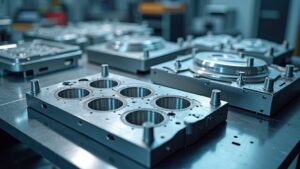Introduction to Injection Molding
Injection molding is a manufacturing process for creating parts from thermoplastic materials. The process involves melting the plastic and injecting it into a mold, where it cools and solidifies. The mold is then opened, and the part is ejected. For more information on plastic injection molding, you can visit plastic injection molding at plastic injection molding at hansenplastics.com.
Injection molding is a versatile process that can be used to create a wide variety of parts, including toys, appliances, automotive parts, and medical devices. It is a high-volume process, which means that it can be used to produce large quantities of parts quickly and efficiently.
The Injection Molding Process
The injection molding process consists of the following steps:
- Material Preparation: The plastic material is first prepared by melting it in a hopper. The temperature of the plastic is controlled to ensure that it melts evenly.
- Injection: The molten plastic is then injected into the mold under high pressure. The pressure of the injection helps to ensure that the plastic fills the mold completely.
- Cooling: The mold is then cooled, which causes the plastic to solidify. The cooling time depends on the type of plastic being used.
- Ejection: Once the plastic has solidified, the mold is opened and the part is ejected.
The Benefits of Injection Molding
There are many benefits to using injection molding, including:
- High production volume: Injection molding is a high-volume process, which means that it can be used to produce large quantities of parts quickly and efficiently.
- Complex shapes: Injection molding can be used to create complex shapes that would be difficult or impossible to produce using other manufacturing methods.
- Durability: Injection molded parts are typically very durable and can withstand a lot of wear and tear.
- Cost-effectiveness: Injection molding is a cost-effective manufacturing process, especially for high-volume production.
The Limitations of Injection Molding
There are a few limitations to injection molding, including:
- High initial cost: The upfront cost of setting up an injection molding operation can be high.
- Mold design: The design of the mold is critical to the success of the injection molding process. A poorly designed mold can lead to defects in the finished parts.
- Material selection: The type of plastic used in injection molding can affect the properties of the finished parts. It is important to select the right material for the application.
Applications of Injection Molding
Injection molding is used to create a wide variety of parts, including:
- Toys
- Appliances
- Automotive parts
- Medical devices
- Electronic components
- Packaging
- Sporting goods
- Furniture
- Construction materials
The Future of Injection Molding
The future of injection molding looks bright. The demand for plastic parts is expected to grow in the coming years, and injection molding is well-positioned to meet this demand.
There are a number of trends that are expected to shape the future of injection molding, including:
- The development of new plastics with improved properties.
- The use of automation to improve efficiency and productivity.
- The use of 3D printing to create molds. Learn more about 3d printing vs injection molding .
These trends are expected to make injection molding even more versatile and efficient in the years to come.
Frequently Asked Questions (FAQs)
1. What are the different types of injection molding?
There are two main types of injection molding: hot runner and cold runner.
- Hot runner: In hot runner injection molding, the plastic is heated and injected directly into the mold. This type of injection molding is more efficient than cold runner injection molding, but it is also more expensive.
- Cold runner: In cold runner injection molding, the plastic is injected into a runner system that is connected to the mold. The runner system cools the plastic before it enters the mold. This type of injection molding is less expensive than hot runner injection molding, but it is also less efficient.
Also learn more about types of Injection Molding Machines .
2. What are the different types of plastic that can be used in injection molding?
There are many different types of plastic that can be used in injection molding. Some of the most common plastics include:
- Acrylonitrile butadiene styrene (ABS): ABS is a strong and durable plastic that is often used in automotive and appliance applications.
- Polyethylene terephthalate (PET): PET is a clear and lightweight plastic that is often used in food and beverage packaging.
- Polypropylene (PP): PP is a strong and versatile plastic that is often used in a variety of applications, including automotive, packaging, and consumer goods.
- Polystyrene (PS): PS is a clear and lightweight plastic that is often used in disposable products, such as cups and plates.
- Nylon: Nylon is a strong and durable plastic that is often used in gears, bearings, and other mechanical components
Injection Molding alternative is Compression molding . It is a method of molding in which the molding material, generally preheated, is first placed in an open, heated mold cavity.








